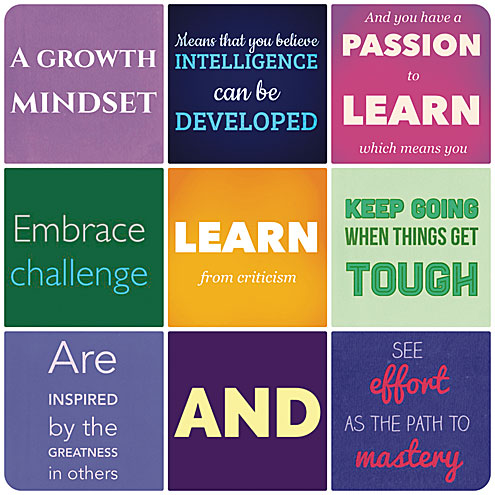By Tamra Taylor
If we can help them understand that meaningful success is almost always the result of applying grit, determination, and purposeful engagement, then we will have provided them with an important foundation for success.
The premise of the self-esteem movement of the last decade was that frequent, generalized praise develops strong self-confidence and this self-confidence results in greater student achievement. Instead of this intended outcome, Stanford University’s world-renowned psychology researcher Carol Dweck found that students frequently praised for their talent and smarts often shy away from the risk involved in tackling complex problems.

Dweck’s work has profound implications for school and the workplace. In simple terms, her premise is that in a fixed mindset students believe their basic qualities, like intelligence and talent, are static and they are born with a fixed amount. In a growth mindset, students believe that talent and “brains” are just a starting point and that their most basic abilities can be developed through dedication and hard work.
The growth mindset fosters a love of learning and a resilience that is essential to great achievement. Indeed there are countless examples of athletes (Michael Jordan), scientists (Thomas Edison), creators (Walt Disney), and musicians (The Beatles) who have met with initial failure only to persevere and through their grit become world famous in the area they once failed in.
While they are working on a problem instead of telling them, “I know you can do this because you are so smart” or “Don’t worry, not everybody is good at math” we can instead tell them, “ I noticed you tried three different ways to solve that problem.
Using different strategies will help you solve the next problem also” or “You have grit; I noticed you worked on that problem for 20 minutes and you did not give up.” Other ways to instill the growth mindset are to formally teach students strategies for looking at their mistakes and give them multiple opportunities to meet their goal.
Shoreline Middle School offers an example as to how we are integrating the growth mindset philosophy into the student experience. For instance, each math teacher began the year with the “Week of Inspirational Math,” which was a week of mathematics instruction dedicated to mindset including videos.
During class, students are asked to share “gifts” with the class (gifts are errors/mistakes) and a whole group discussion is dedicated to learning from these gifts. This approach was adopted so that students would value the learning that comes from mistakes. Additionally, teachers offer and encourage test corrections and lead collaborative class discussions that help students re-engage with prior concepts in a new way.
There is also an effort to change the language used by teachers and students to encourage a growth mindset. There is a bulletin board in Shoreline staff lounge, which shows phrases teachers can use with students and similar posters can be found in each math classroom.
Students are explicitly taught the power of “…yet!” with teachers reminding students that learning takes time and they may not know it …yet. So instead of saying “I don’t get it” students are asked to say “I don’t know it …yet.”
Mindset is also a focus of teachers at the elementary level and during our spring conferences, teachers will briefly share with parents the importance of a growth mindset. Students will then present a portfolio of work to their parent/guardian and share what they have learned, their goals for future learning and how they plan to reach these goals.
In summary, Live Oak teachers are working to transform the meaning of effort and difficulty so that their students are prepared to tackle the complex problems facing the world and be valuable contributors to finding solutions and opportunities.